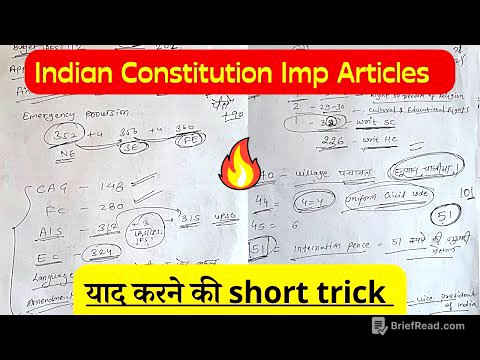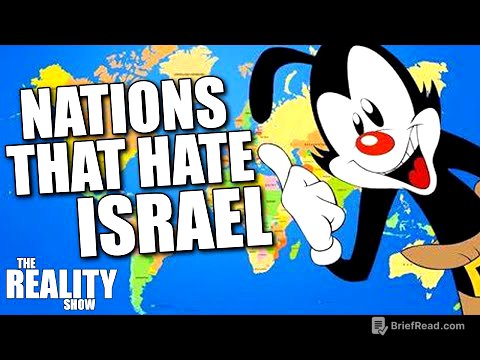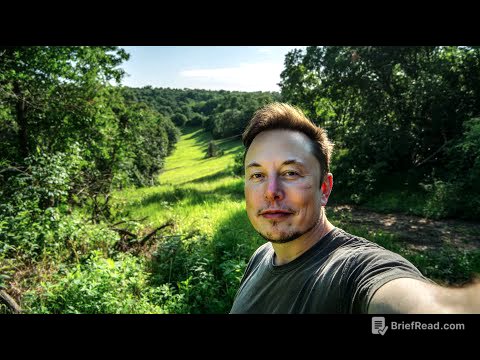TLDR;
This video explains how the economic machine works by breaking it down into simple parts and transactions. It identifies three main forces driving the economy: productivity growth, the short-term debt cycle, and the long-term debt cycle. The video stresses the importance of understanding credit, how borrowing creates cycles, and the roles of the central bank and government in managing the economy, especially during deleveraging periods.
- The economy is driven by transactions involving money and credit.
- Credit is crucial but often misunderstood; it amplifies economic cycles.
- Central banks and governments play key roles in influencing interest rates and managing debt.
- Balancing deflationary and inflationary measures is essential for a "beautiful deleveraging."
Introduction to the Economic Machine [0:00]
The economy functions like a simple machine, composed of numerous transactions driven by human nature. These transactions create three primary forces: productivity growth, the short-term debt cycle, and the long-term debt cycle. By understanding these forces and how they interact, one can develop a template for tracking economic movements and understanding current economic events.
Transactions: The Building Blocks of the Economy [0:26]
An economy is the sum of all transactions, each involving a buyer exchanging money or credit with a seller for goods, services, or financial assets. Total spending, which includes both money and credit, drives the economy; dividing this by the quantity sold determines the price. These transactions are the foundation of all economic cycles and forces, making their understanding crucial for grasping the entire economy.
The Role of Government and Credit [0:59]
Participants in the economy include individuals, businesses, banks, and governments, all engaging in transactions. The government, comprising the Central Government and the Central Bank, is the largest player. The Central Bank is unique because it controls the money and credit supply by influencing interest rates and printing money, making it a key figure in the flow of credit.
Understanding Credit and Debt [1:14]
Credit is the most important and misunderstood aspect of the economy, acting as both an asset for lenders and a liability for borrowers. When borrowers repay loans with interest, the asset and liability disappear, settling the transaction. Credit is vital because it enables borrowers to increase spending, which in turn drives the economy, as one person's spending becomes another's income.
The Impact of Credit on Economic Growth [0:01]
Increased income enhances creditworthiness, leading to more borrowing and spending, which fuels economic growth. This pattern creates cycles, with productivity growth being a long-term factor and credit a short-term one. Credit allows consumption beyond production, creating debt swings in cycles of about 5-8 years and 75-100 years.
The Mechanics of Borrowing and Spending [0:01]
Borrowing is a way to pull spending forward, requiring future reduction in spending to repay the debt, thus creating a cycle. Credit differs from money; money settles transactions immediately, while credit is a promise to pay later. Credit is not inherently bad but becomes so when it finances unsustainable over-consumption.
Credit's Role in Economic Expansion [0:02]
In an economy with credit, spending can increase beyond what is produced, causing incomes to rise faster than productivity in the short term. For example, someone earning $100,000 a year can borrow an additional $10,000, spend $110,000, and thereby increase another person's income. This self-reinforcing pattern demonstrates how credit drives economic expansion, but it also creates cycles that eventually lead to contraction.
The Short Term Debt Cycle [0:02]
As economic activity rises, an expansion occurs, leading to increased spending and rising prices, known as inflation. Central Banks counteract inflation by raising interest rates, making borrowing more expensive and reducing spending, which can lead to deflation and a recession. If a recession becomes too severe, central banks lower interest rates to stimulate borrowing and spending, initiating another expansion.
The Long Term Debt Cycle [0:03]
Over time, debts rise faster than incomes, leading to the long-term debt cycle. Lenders become more willing to extend credit as incomes and asset values rise, creating a boom and a bubble. However, debt burdens eventually become too large, causing debt repayments to grow faster than incomes, forcing people to cut back on spending and reversing the cycle.
Deleveraging and Its Consequences [0:03]
When debt burdens become unsustainable, the economy begins deleveraging, characterized by reduced spending, falling incomes, and disappearing credit. Asset prices drop, banks face pressure, and social tensions rise. This phase resembles a recession, but interest rates cannot be lowered to stimulate borrowing because they are already near zero.
Four Ways to Reduce Debt Burden [0:04]
To address deleveraging, there are four main strategies: cutting spending, reducing debt through defaults and restructurings, redistributing wealth, and printing new money. Cutting spending leads to austerity, which can worsen the debt burden as incomes fall faster than debts are repaid. Debt reduction, though necessary, causes incomes and asset values to disappear faster.
Government Actions During Deleveraging [0:04]
During deleveraging, governments face budget deficits due to lower tax revenues and increased spending on unemployment support and stimulus plans. They may raise taxes on the wealthy to redistribute wealth, leading to social tensions. Central banks print new money to buy financial assets and government bonds, aiming to stimulate the economy.
The Possibility of a Beautiful Deleveraging [0:04]
A "beautiful deleveraging" involves balancing deflationary and inflationary measures to reduce debt relative to income while maintaining positive real economic growth and avoiding high inflation. This requires a mix of cutting spending, reducing debt, transferring wealth, and printing money to maintain economic and social stability. Printing money can offset falling credit and stimulate income growth.
Achieving Economic Stability and Growth [0:05]
To turn things around, income growth must exceed the interest rate on accumulated debt. Policymakers must avoid printing too much money, which can cause high inflation. When incomes rise, borrowers become more creditworthy, lenders resume lending, and the economy begins to grow again, leading to the reflation phase of the long-term debt cycle.
Summary and Rules of Thumb [0:05]
In summary, the video provides three rules of thumb: avoid debt rising faster than income, prevent income from rising faster than productivity, and prioritize raising productivity. These principles apply to both individuals and policymakers, offering a template for understanding economic dynamics and making informed decisions.









